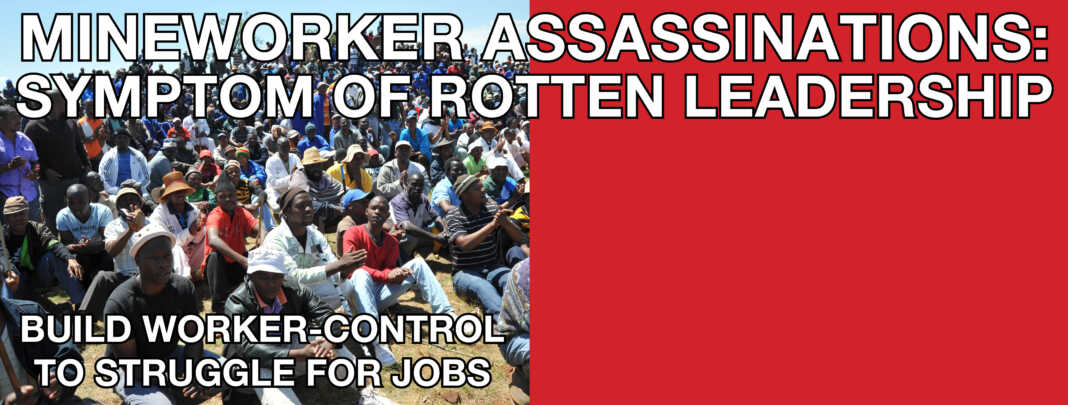Build worker-control to struggle for jobs
by Mamtelwe Sebei, Executive Committee
The Mail & Guardian’s damning report of brutal purges of former mineworkers-committee members, who heroically led the 2012 mineworkers’ strikes, by AMCU’s leadership, confirms the perspectives and warnings which WASP alone made long ago. None of the shocking charges laid against the AMCU leadership comes as a surprise to us nor is this an unexpected turn of events. The degeneration of the AMCU leadership into a violent authoritarian clique flows directly from their theoretical bankruptcy and political impotence in the face of the crisis of the mining industry. They neither understand this crisis nor have an answer to its devastating consequences on the workers, their families and their communities. In spite of all the threats against the mine bosses from AMCU president, Joseph Mathunjwa, there has been absolutely nothing by way of a serious response to the closures of mines, loss of jobs and the wreaking of collective agreements.
It would be unfair to accuse, without evidence, the AMCU leadership of involvement in the assassinations currently taking place. But understandably suspicions have been raised against the leadership in the light of the disturbing patterns in the assassinations. They seem directed against anyone opposed to the union leadership. This is not enough to make definitive conclusions of criminal responsibility, but the AMCU leadership cannot be absolved from the political responsibility for the brutal factional war raging in the ranks of their union.
The factional struggle that appears to be behind the killings emanates not only from their backward political ideas and grovelling for ‘acceptance’ by the mining bosses. This is itself a product of their dismal failure to unify mineworkers behind a clear fighting strategy and political programme of the kind we have argued for since 2012. This is notwithstanding the five month platinum wage strike of 2014. This strike took place little more than a year after the 2012 strikes and before Mathunjwa and his clique had consolidated their position. That the struggle took place under the banner of AMCU was not a reflection of the militancy or farsightedness of Mathunjwa’s leadership, despite many on the left making the mistake of thinking so, but was driven by a feeling of ‘unfinished business’ amongst mineworkers, that it would have been impossible for Mathunjwa to stand in the way of. But even here, Mathunjwa’s role was to dampen militancy. In his endless media appearances the former prominent demand for mine nationalisation under democratic worker control was now gone as was the mineworkers’ support for the building of a mass workers’ party – this despite national elections being only months away.
The lack of a decisive lead since, not only confirms this analysis, but has unfortunately demoralised AMCU members and sown the seeds of factional hostilities between workers’ leaders divided over the paralysis of the union. The political responsibility of the AMCU leadership for the present atmosphere lies directly on their habit of inciting witch-hunts against worker militants opposed to their disastrous policies and authoritarian rule.
Starting with an AMCU rally at the end of the 2012 strikes, Mathunjwa has consistently abused platforms in mass meetings to publicly defame respected workers leaders. It has become customary for him to use mass meetings and rallies for his pseudo-religious rantings and demagogic denunciations, without debate and opportunity to reply, of workers who dare to question his leadership and political incompetence to guide the workers on the most fundamental questions of strategy and programme.
From the moment AMCU secured a mass base in Rustenburg its members have been faced with job losses, restructuring and mine closures and victimisation of activists. The bosses have strived to co-opt AMCU, the same way they co-opted NUM before it, into assisting in the maintenance of the horrendous migrant labour regime, with its slave-conditions for black mineworkers. In spite of all this belligerence from the mining bosses, nothing has been forth-coming from AMCU leadership, by way of clear fighting strategy, trade union education and adequate support to guide workers in their life and death struggle with the most politically cunning section of the capitalist class.
Mathunjwa has openly denounced and prohibited contact with any socialist and left activists including the Democratic Socialist Movement (forerunner of WASP), which along with democratically elected strike-committees provided strategic leadership, active political solidarity and vital technical support to 2012 mineworkers’ strikes. Along with this, and precisely to cover-up his political betrayal, Mathunjwa has embraced right-wing parties, including those funded by mine-bosses, such as the likes of the DA.
Such political ‘direction’ as Mathunjwa has provided for the mineworkers, whose rebellion on the platinum belt was far more than a strike against slave wages and conditions but a political uprising against the entire political establishment, far from taking workers forward, as DSM in collaboration with the national strike committee sought to with the launch of WASP, appears to be motivated by tribal considerations. Platforms have also been given to the UDM and APC which can fuel tribal divisions and in turn crippling, violent factionalism. Recent commemorations of the Marikana massacre have become platforms for these anti-working class bourgeois politicians as well as the Lonmin bosses to justify their criminal complicity in the massacre. This is both symptomatic of this right-ward political shift and an insult to the memory of the immortal 16 August martyrs.
WASP is calling for the revival and organisation of rank-and-file committees to reclaim their organisations and build them on workers control, struggle and socialism as the only viable alternative to the crisis of South African mining and world capitalism. As we have said before, it is only a democratic, worker-controlled and fighting trade union movement in the mining industry that can unify workers for a fightback against job losses and for decent conditions of work and life in mining-affected communities.

